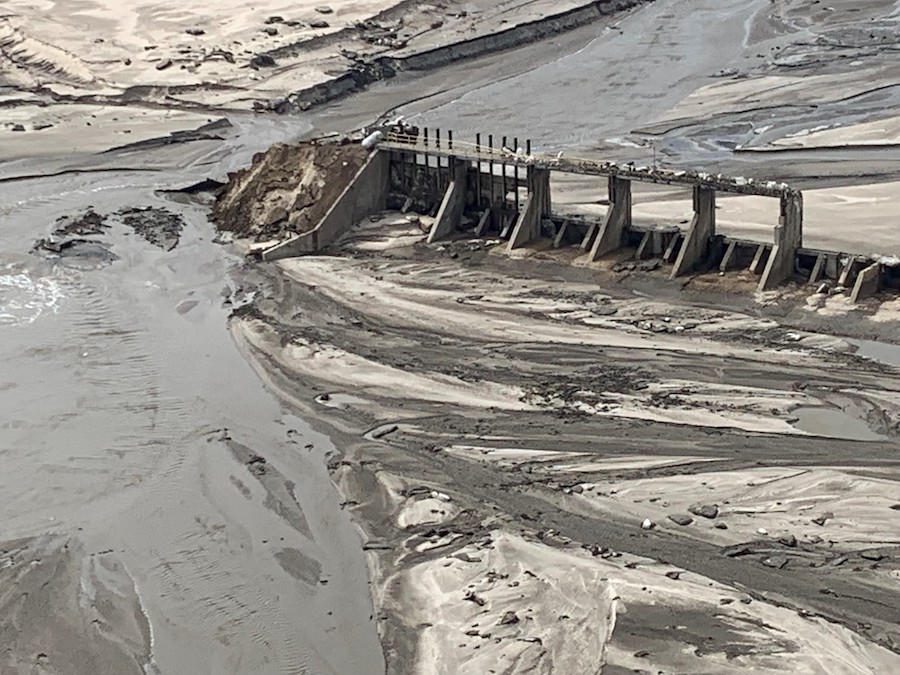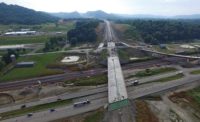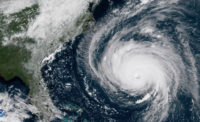Historic Midwest Flooding Destroys Roads, Bridges, Dams and Levees
And Waters Keep On Rising

The Spencer Dam was destroyed by flood rivers on the Niobrara River on March 14.
Photo courtesy of the Office of Governor Pete Ricketts.
Midwestern floodwaters have topped or breached multiple levees, damaged bridges and roads, destroyed one dam and damaged another and inundated at least 42 wastewater treatment plants as historic flooding continues to hit Nebraska, Iowa and Missouri. At least two people are reported dead.
Nine levees in total have been breached on both sides of the Missouri River, and “additional breaches are possible,” says Mike Glasch, deputy director of public affairs for the Army Corps’ Omaha District. “We are continuing to work with state and local agencies to monitor the levees,” he adds.
The Missouri River should crest within 24 hours between Omaha and Nebraska City and reach peak flows farther south later in the week, Glasch says. But those water levels will depend upon the weather, he adds, with an additional .5 in. of rain expected in the area this week.
“We are continuing to help supply agencies with whatever they need — sand, supersacks, Hescos and so on,” Glasch says.
Major and moderate flooding is expected to continue into next week, according to a March 18 Federal Emergency Management Agency briefing that also detailed the extent of known damage to infrastructure.
“We are still in a flood fight,” says James Camoriano, spokesman for HDR, based in Omaha, Neb. While Omaha is not flooded, several areas around the city are. Camoriano says HDR is working with clients to examine roads, treatment plants, railroads and other infrastructure, but comprehensive assessments can’t occur until floodwaters recede.
HDR has employees at one of the wastewater treatment plants that flooded when a nearby creek overtopped a levee. Several other employees live in the flooded areas, Camoriano says.
The flooding is unprecedented, with both the Missouri and Platte rivers and many of their tributaries flooding at the same time. “One will typically rise, but not both,” he says.
FEMA says heavy rainfall in early March in the Missouri and Mississippi river basins caused rapid snow melt, exacerbated by a “bomb cyclone,” an unusually strong blizzard that swept across seven western states last week. However, ice remained in the waterways, causing additional problems. The broken ice and high water caused the Spencer Dam on the Niobrara River to fail March 14. The waters swept away part of U.S. 281, downstream from the dam.
At least 14 bridges are washed out, missing or have the approaches washed out out in Nebraska, according to Jeni Campana of the Nebraska Dept. of Transportation.
The Nebraska Public Power District was still operating its Cooper Nuclear Station along the Missouri River, though it has armed the plant with thousands of sandbags. The facility would have to shut down if the water level reaches 902 ft mean sea level. Currently, the level is 898.9 ft and dropping, according to the district.
On his Facebook page, Nebraska Gov. Pete Ricketts said he visited Plattsmouth on the Missouri River on Monday morning. “Their water treatment plant is under water, with millions of dollars in damage. In 2011, it took 108 days for water to subside, and this year the water is 4-5 feet higher,” he wrote.
Lincoln, Neb., declared a Level 2 Water Use Restriction Emergency on Sunday night after flooding and power losses affected operation of the aquifer pumps near there.
FEMA also said the U.S. Army Corps of Engineers is reducing discharge at Gavins Point Dam in Nebraska to lessen downstream impacts. In Iowa, the agency reported that significant damage was expected at the Joe Reisner Dam in Humboldt County due to ice jams, and three levees on the Missouri River had been breached. As of Monday morning, 51 state highways were closed in Nebraska, several roads were closed in Iowa, and a portion of Interstate 29 was closed in Missouri.
Once the flooding ends, HDR will be involved in the cleanup, recovery and restoration, Camoriano says. “And we will aim at more hardened facilities to help in more flood protection.”






